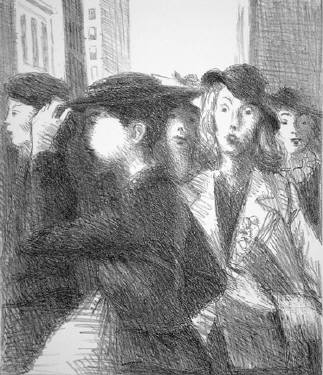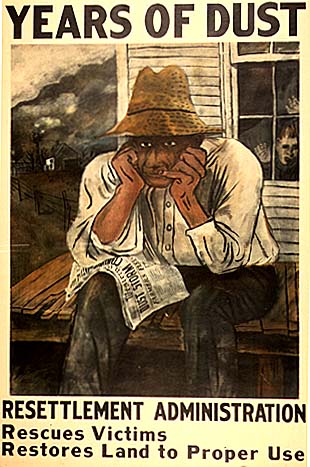The Great Depression changed the way America looked at art. Artists began to focus more on people and telling the stories of those living through the Great Depression. The New Deal also fueled a new wave of political activist art. Since artists were being patronized by the government under the Federal Art Project, many created works in support of their government.
Portraying the Working Woman.

“Working Girls Going Home” by Raphael Soyer is a great example of how artists celebrated the lives of ordinary people during the Great Depression. Soyer completed this work in New York in 1937, while the Depression was still going on. It portrays ordinary women coming home after a long day’s work. Some things people have noted about this piece of art is that all of the women look almost identical and are wearing very similar clothing. This gives the painting a very melancholy and grim feeling. Soyer was trying to capture how he saw the women, and how they were feeling. And by showing their hardships, celebrate the working people.
Political Activism and Art.

One of the most famous political activist artists of the Great Depression was Dorothea Lange. Lange was a photographer who set out to document the lives and hardships of migrant workers during the Great Depression. The photograph pictured above titled “ Migrant Mother” is one of her most famous works. Lang’s Works realistically portrayed migrant workers difficulties during the Depression and how they lived. In an excerpt included with this photograph in Popular Photography, Lange stated that “She said that they had been living on frozen vegetables from the surrounding fields, and birds that the children killed. She had just sold the tires from her car to buy food”. In the photo the mother stares into the distance with her brow furrowed. Her children face away from the camera and huddle around her. The inclusion of the children makes the situation and the photograph particularly difficult to look at. Although this picture is very sad, it is an excellent portrayal of what people had to live through during the Great Depression.
The New Deal and Artists.

The New Deal created many new opportunities for artists during the Great Depression. Under the Federal Arts Act, the government began to patronize the arts. Artist created works advertising and celebrating the new services the government was supplying to the people. “Years of Dust” by Ben Shahn is one of these pieces of art. “Years of Dust” portrays a poor farmer hit hard by many years of drought. Under the picture of the farmer Shahn advertises the services of the Resettlement Administration stating that they “rescue victims and restore land to proper use”. Shahn was obviously a supporter of the new deal; and how it was helping him and other Americans get back on their feet.
Works Cited:
“Raphael Soyer (1899-1987).” Raphael Soyer. Expert Art Authentication, Certificates of Authenticity and Expert Art Appraisals. N.p., n.d. Web. 30 Oct. 2016. <https://www.artexpertswebsite.com/pages/artists/soyer_raphael.php>.
“A New Deal for the Arts.” National Archives and Records Administration. National Archives and Records Administration, n.d. Web. 30 Oct. 2016. <https://www.archives.gov/exhibits/new_deal_for_the_arts/index.html>.
“BACKGROUND AND HISTORY.” Lange Fellowship. N.p., n.d. Web. 30 Oct. 2016. <http://www.berkeley.edu/lange/history.shtml>.
Nice blog post, Lily. I really liked how you made the connection not only to the Great Depression but also the political issues that were occurring during this time. I also focused on The Great Depression in my blog post and used “Migrant Mother” as one of my works. I like that you pointed out the facial expressions of the mother and gave more background information on this piece. I thought that the children also really look like they’re seeking reassurance and safety from their mother in this photo. I followed one of the links that you posted in your works cited page to learn more about Raphael Soyer and his work, “Working Girls Going Home”. I also looked at more of his art on this website.
LikeLike
This was a good informative post. I did notice that the women in the first piece were very similar looking. I read that many pieces by Soyer were to portray “a series of episodes in the lives of simple, even drab human beings.” (https://www.archives.gov/exhibits/new_deal_for_the_arts/celebrating_the_people1.html)
Also, I like that you used a piece of propaganda to talk about. There was so much propaganda used during WWI and I was trying to find a good piece to use that went with the rest of my post. My searching skills where not very good though. After looking at the piece for a moment, I noticed another person in the window. I wonder if that person has a purpose or meaning to that piece.
LikeLike
You wrote a great post about the arts in the Great Depression. I love “Migrant Mother” it is such a historically significant photograph. I love that you went into detail about the events that led to this photo. It perfectly explains the woman’s expression. What made you choose to write about the photo? Lange was actually an established photographer before she started documenting migrant workers during the Great Depression.
LikeLike